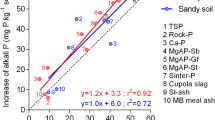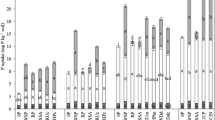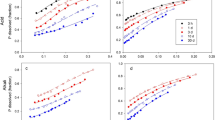Abstract
An isotopic exchange method, based on tracer kinetic theory, was used to study the dissolution (Fin) and retention (Fout) of Phosphate (P) fertilizers in the soil. This method involves labelling of the soil with carrier-free32P-phosphate ions, and monitoring changes with time of specific activity of isotopically exchangeable phosphate in the soil as extracted by plants, and of the amounts of readily exchangeable P. To assess this method, experiments were carried out to determine the rates of release and retention of phosphate from three fertilizers, monocalcium phosphate (MCP), ground North Carolina phosphate rock (NCPR < 150µm), and 30% acidulated (with phosphoric acid) NCPR (NCPAPR), in two soils, Tekapo fine sandy loam and Craigieburn silt loam. MCP was applied at 75 and 150µg g−1 soil; NCPR was applied at 150 and 750µg g−1 soil; and NCPAPR was applied at 150µg g−1 soil. After 1, 50 and 111 days of incubation, the treated soil samples were labelled with carrier-free32P-phosphate ions, and perennial ryegrass (Lolium perenne) was grown to sample specific activity in these samples. Results showed that the changing patterns of exchangeable P in the soils as affected by fertilizer solubility and application rate could be clearly explained by the values of Fin and Fout. With increasing period of soil-fertilizer contact, the P added in the form of MCP solution was rapidly transformed into non-exchangeable forms (high Fout value). Exchangeable P in the NCPR and NCPAPR treated soils were maintained at steady concentrations for extended periods due to the continued release of P from the fertilizer material (steady Fin) and lower rates of P retention by the soil (smaller Fout). The dissolution rate of NCPR at the lower application rate was smaller in absolute terms, but greater in relative terms.
Similar content being viewed by others
References
Blakemore LC, Searle PL and Daly BK (1987) Methods for chemical analysis of soils. NZ Soil Bur Sci Report 80: 31–45
Bolan NS and Hedley MJ (1989) Dissolution of phosphate rocks in soils.1. Evaluation of extraction methods for the measurement of phosphate rock dissolution. Fert Res 19: 65–75
Bolan NS, White RE and Hedley MJ (1990a) A review of the use of phosphate rocks as fertilizers for direct application in Australia and New Zealand. Aust J Exp Agric 30: 297–313
Bolan NS, Hedley MJ, Harrison R and Braithwaite AC (1990b) Influence of manufacturing variables on characteristics and the agronomic value of partially acidulated phosphate fertilizers. Fert Res 26:119–138
Bolland MDA and Gilkes RJ (1990) Rock phosphates are not effective fertilizers in Western Australian soils: a review of one hundred years of research. Fert Res 22: 79–95
Chu CR, Moschler WW and Thomas GW (1962) Rock phosphate transformations in acid soils. Soil Sci Soc Am Proc 26: 476–478
Dalal RC (1977) Soil organic phosphorus. Adv Agron 29: 85–117
Hughes JC and Gilkes RJ (1984) The effect of chemical extractant on the estimation of rock phosphate fertilizer dissolution. Aust J Soil Res 22: 475–481
Hughes JC and Gilkes RJ (1986a) The effect of rock phosphate properties on the extent of fertilizer dissolution in soils. Aust J Soil Res 24: 209–217
Hughes JC and Gilkes RJ (1986b) The effect of soil properties and level of fertilizer application on the dissolution of Sechura rock phosphate in some soils from Brazil, Colombia, Australia and Nigeria. Aust J Soil Res 24: 219–227
Kanabo IAK and Gilkes RJ (1987) A comparison between plant response and chemical measurements of the dissolution of reactive phosphate rock in soils of different pH and phosphorus retention. Aust J Soil Res 25: 451–460
Kanabo IAK and Gilkes RJ (1988) The effect of particle size of North Carolina phosphate rock on its dissolution in soil and on levels of bicarbonate-soluble phosphorus. Fert Res 15: 137–145
Khasawneh FE and Doll EC (1978) The use of phosphate rock for direct application to soils. Adv Agron 30: 159–206
Kirk GJD and Nye PH (1986) A simple model for predicting the rates of dissolution of sparingly soluble calcium phosphates. II. Application of the model. J Soil Sci 37: 541–554
L'Annunziata MF (1984) The detection and measurement of radionuclides. In: L'Annunziata MF and Legg JO (eds) Isotopes and Radiation in Agricultural Sciences, Volume I: Soil-Plant-Water Relations, pp 41–231. Academic Press, London
Larsen S (1952) The use of P32 in studies on the uptake of phosphorus by plants. Plant Soil 4:1–10
Mackay AD, Syers JK, Tillman RW and Gregg PEH (1986) A simple model to describe the dissolution of phosphate rock in soils. Soil Sci Soc Am J 50: 291–296
Middleton KR and Toxopeus MRJ (1973) Diagnosis and measurement of multiple soil deficiencies by a subtractive technique. Plant Soil 38: 219–226
Olsen SR and Sommers LE (1982) Phosphorus. In: Page AL (ed) Methods of Soil Analysis, Part 2, Chemical and Microbiological Properties. 2nd ed, pp 403–430. Am Soc Agron, Madison, Wisconsin, USA
Shipley RA and Clark RE (1972) Tracer Methods forin vivo Kinetics, Theory and Applications. Academic Press, New York. 239 p
Smyth TJ and Sanchez PA (1982) Phosphate rock dissolution and availability in Cerrado soils as affected by phosphorus sorption capacity. Soil Sci Soc Am J 46: 339–345
Stanford G and Dement JD (1957) A method for measuring shortterm nutrient absorption by plants: I. Phosphorus. Soil Sci Soc Am Proc 21: 612–617
Syers JK and Mackay AD (1986) Reactions of Sechura phosphate rock and single superphosphate in soil. Soil Sci Soc Am J 50: 480–485
Author information
Authors and Affiliations
Rights and permissions
About this article
Cite this article
Di, H.J., Harrison, R. & Campbell, A.S. Assessment of methods for studying the dissolution of phosphate fertilizers of differing solubility in soil. Fertilizer Research 38, 1–9 (1994). https://doi.org/10.1007/BF00750057
Received:
Accepted:
Issue Date:
DOI: https://doi.org/10.1007/BF00750057




